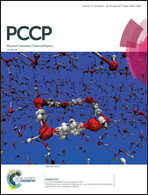Pyrene based D–π–A architectures: synthesis, density functional theory, photophysics and electron transfer dynamics†
Abstract
Pyrene derivatives show immense potential as sensitizers for dye-sensitized solar cells (DSCs). Therefore, this work focuses on the impact of π-spacers on the photophysical, electrochemical and photovoltaic properties of pyrene based D–π–A dyes, since the insertion of π-spacers is one of the doable strategies to improve the light harvesting properties of the dye. In this respect, three new pyrene based D–π–A dyes have been synthesized and characterized by 1H, 13C NMR, and elemental analyses and EI-MS spectrometry. The selected π-spacers are benzene, thiophene and furan. Compared with a benzene spacer, the introduction of a heterocyclic ring spacer reduces the band gap of the dye and brings about the broadening of the absorption spectra to the longer wavelength region through intramolecular charge-transfer (ICT). Combined experimental and theoretical studies were performed to investigate the ICT process involved in the pyrene derivatives. The profound solvatochromism with increased nonradiative rate constants (knr) has been construed in terms of ICT from the pyrene core to rhodanine-3-acetic acid via conjugated π-spacers. Electrochemical data also reveal that the HOMO and LUMO energy levels are fine-tuned by incorporating different π-spacers between pyrene and rhodanine-3-acetic acid. On the basis of the optimized DSC test conditions, the best performance was found for PBRA, in which a benzene group is the conjugated π-spacer. The divergence in the photovoltaic behaviors of these dyes was further explicated by femtosecond fluorescence and electrochemical impedance spectroscopy.



 Please wait while we load your content...
Please wait while we load your content...